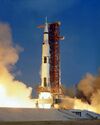Astronomy:Saturn-Shuttle
 NASA model of Saturn-Shuttle configuration | |
| Function | Crewed LEO launch vehicle |
|---|---|
| Manufacturer | Boeing (S-IC) Martin Marietta (External Tank) Rockwell International (Space Shuttle orbiter) |
| Country of origin | United States |
| Size | |
| Height | 86 m (281 ft)[1] |
| Diameter | 10 m (33 ft)[1] |
| Mass | 2,300,000 kg (5,070,000 lb)[1] |
| Stages | 2 |
| Capacity | |
| Payload to LEO | 60,500 kg (133,400 lb)[1] |
| Launch history | |
| Status | Canceled |
| Launch sites | Kennedy LC-39 |
| First stage – S-IC | |
| Length | 137.99 ft (42.06 m)[1] |
| Diameter | 33 ft (10 m)[1] |
| Empty mass | 298,104 lb (135,218 kg)[1] |
| Gross mass | 5,040,245 lb (2,286,217 kg)[1] |
| Engines | 5 Rocketdyne F-1[1] |
| Thrust | 8,700,816 lbf (38,703.16 kN)[1] |
| Specific impulse | 304 seconds (2.98 km/s)[1] |
| Burn time | 161 s[1] |
| Fuel | RP-1/LOX[1] |
| Second stage – External Tank | |
| Length | 153.8 ft (46.9 m)[1] |
| Diameter | 27.5 ft (8.4 m)[1] |
| Empty mass | 65,980 lb (29,930 kg)[1] |
| Gross mass | 1,655,616 lb (750,975 kg)[1] |
| Specific impulse | 455 seconds (4.46 km/s)[1] |
| Burn time | 480 s[1] |
| Fuel | LH2 / LOX[1] |
| Second stage – Orbiter plus External Tank | |
| Engines | 3 SSMEs located on Orbiter[1] |
| Thrust | 5,250 kN (1,180,000 lbf)[1] |
| Specific impulse | 455 seconds (4.46 km/s)[1] |
| Burn time | 480 s[1] |
| Fuel | LH2 / LOX[1] |
The Saturn-Shuttle was a preliminary concept of launching the Space Shuttle orbiter using a modified version of the first stage of the Saturn V rocket.[1] It was studied and considered in 1971–1972.[2]
Description
An interstage would be fitted on top of the S-IC stage to support the external tank in the space occupied by the S-II stage in the Saturn V. It was an alternative to the SRBs.[1]
The addition of wings (and some form of landing gear) on the S-IC stage would allow the booster to fly back to the Kennedy Space Center, where technicians would then refurbish the booster (by replacing only the five F-1 engines and reusing the tanks and other hardware for later flights).[1]
The Shuttle would handle space station logistics, while the Saturn V would launch components.
This would have allowed the International Space Station, using a Skylab or Mir configuration with both U.S. and Russian docking ports, to have been lifted with just a handful of launches. The Saturn-Shuttle concept also would have eliminated the Space Shuttle Solid Rocket Boosters that ultimately precipitated the Space Shuttle Challenger accident in 1986.
See also
References
- ↑ 1.00 1.01 1.02 1.03 1.04 1.05 1.06 1.07 1.08 1.09 1.10 1.11 1.12 1.13 1.14 1.15 1.16 1.17 1.18 1.19 1.20 1.21 1.22 1.23 1.24 1.25 1.26 1.27 "Saturn Shuttle". http://www.astronautix.com/s/saturnshuttle.html.
- ↑ Lindroos, Marcus (June 15, 2001). "Phase B' Shuttle contractor studies 1971". http://www.pmview.com/spaceodysseytwo/spacelvs/sld036.htm.
Further reading
- "Phase B' Shuttle contractor studies 1971". https://www.pmview.com/spaceodysseytwo/spacelvs/sld036.htm.
- "Phase B' Shuttle cost tradeoffs 1971". https://www.pmview.com/spaceodysseytwo/spacelvs/sld037.htm.
External links
- "Shuttle". http://www.astronautix.com/s/shuttle.html.
- Saturn Shuttle with Flyback Booster, video rendering by Hazegrayart
 |





